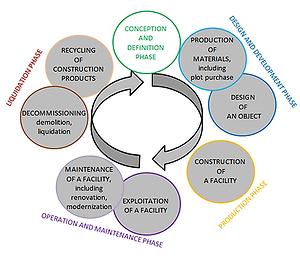Current issue
Online first
Archive
About the Journal
Aims and scope
Editorial Board
International Editorial Board
List of Reviewers
Abstracting and indexing
Ethical standards and procedures
REMV in Social Media
Contact
Instructions for Authors
Instructions for Authors
Manuscript formatting template
Title page
Highlights
Payments
‘Ghostwriting’ and ‘Guestauthorship’
Guidelines for Referees
The Aging of a Building Versus its Life Cycle with Regards to Real Estate Appraisal
1
Faculty of Civil Engineering, Wroclaw University of Science and Technology, Poland
Submission date: 2022-02-17
Final revision date: 2022-04-22
Acceptance date: 2022-05-08
Publication date: 2022-06-18
REMV; 2022;30(2):84-95
HIGHLIGHTS
- the knowledge of the life cycle is the basis for the correct identification of the property's condition
- the liquidation of a building has a big impact on ecological awareness
- the age of the elements of a building may not have a fundamental quantity that determines the course of its technical wear
- the time is not the only parameter of aging
KEYWORDS
TOPICS
C13 - Estimation: GeneralD46 - Value TheoryE32 - Business Fluctuations; CyclesR00 - Urban, Rural, Regional, Real Estate, and Transportation Economics: GeneralR30 - Real Estate Markets, Spatial Production Analysis, and Firm Location: General
ABSTRACT
Construction objects are subjected to aging processes and other changes and influences during their life cycle. The paper focuses on one of the stages of the life cycle of a developed property - the final part of the service life phase.
The paper analyses the problem of classifying a building object to an appropriate life cycle when conducting a real estate valuation. The author searched for the answers to the question of when the liquidation phase begins, because the decommissioning of a building affects the landscape and spatial heterogeneity.
The reasons for demolishing buildings were analysed, and they are as follows: the poor technical condition of building objects; functional wear; difficulties in carrying out renovation or reconstruction works; and financial unprofitability, which takes into account the life phases of buildings.
This paper aims to prove the following theses:
- the knowledge of the life cycle is the basis for the correct identification of a property's condition,
- the age of the elements of a building is not a fundamental quantity that determines the course of its physical depreciation,
- the liquidation of a building has a big impact on ecological awareness.
Share
RELATED ARTICLE
We process personal data collected when visiting the website. The function of obtaining information about users and their behavior is carried out by voluntarily entered information in forms and saving cookies in end devices. Data, including cookies, are used to provide services, improve the user experience and to analyze the traffic in accordance with the Privacy policy. Data are also collected and processed by Google Analytics tool (more).
You can change cookies settings in your browser. Restricted use of cookies in the browser configuration may affect some functionalities of the website.
You can change cookies settings in your browser. Restricted use of cookies in the browser configuration may affect some functionalities of the website.



